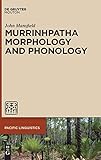Murrinhpatha Morphology and Phonology / John Mansfield.
Material type: TextSeries: Pacific Linguistics [PL] ; 653Publisher: Berlin ; Boston : De Gruyter Mouton, [2019]Copyright date: ©2019Description: 1 online resource (XVIII, 296 p.)Content type:
TextSeries: Pacific Linguistics [PL] ; 653Publisher: Berlin ; Boston : De Gruyter Mouton, [2019]Copyright date: ©2019Description: 1 online resource (XVIII, 296 p.)Content type: - 9781501511394
- 9781501503108
- 9781501503306
- 499.15 23/ger/20231120
- PL7101.M79 M36 2019
- online - DeGruyter
- Issued also in print.
| Item type | Current library | Call number | URL | Status | Notes | Barcode | |
|---|---|---|---|---|---|---|---|
 eBook
eBook
|
Biblioteca "Angelicum" Pont. Univ. S.Tommaso d'Aquino Nuvola online | online - DeGruyter (Browse shelf(Opens below)) | Online access | Not for loan (Accesso limitato) | Accesso per gli utenti autorizzati / Access for authorized users | (dgr)9781501503306 |
Frontmatter -- Acknowledgements -- Contents -- List of Tables -- List of Figures -- Abbreviations and glossing conventions -- 1. Introduction -- 2. Social setting and language ecology -- 3. Segmental sound patterns -- 4. Morphologically specific sound patterns -- 5. Finite verb stem inflection -- 6. Predicate inflectional suffixes -- 7. Nominal and phrasal morphology -- 8. Complex verbs and compounding -- 9. Murrinhpatha wordhood and gradient morphology -- Appendix I -- Appendix II -- References -- Index
restricted access online access with authorization star
http://purl.org/coar/access_right/c_16ec
Murrinhpatha is an Australian Aboriginal language spoken in a region of tropical savannah and tidal inlets on the north coast of the continent. Some 3000 speakers live mostly in the towns of Wadeye and Nganmarriyanga, though they maintain close ties to their traditional lands, totems and spirit ancestors. Murrinhpatha word structure is highly complex, and quite distinct from the better-known Pama-Nyungan languages of central and southern Australia. Murrinhpatha is characterised by prolific compounding, clitic clusters, cumulative inflection, irregular allomorphy and phonological assimilation. This book provides a comprehensive account of these phenomena, giving particular attention to questions of morphological constituency, lexical storage, and whether there is really such thing as a ‘word’ unit.
Issued also in print.
Mode of access: Internet via World Wide Web.
In English.
Description based on online resource; title from PDF title page (publisher's Web site, viewed 25. Jun 2024)


